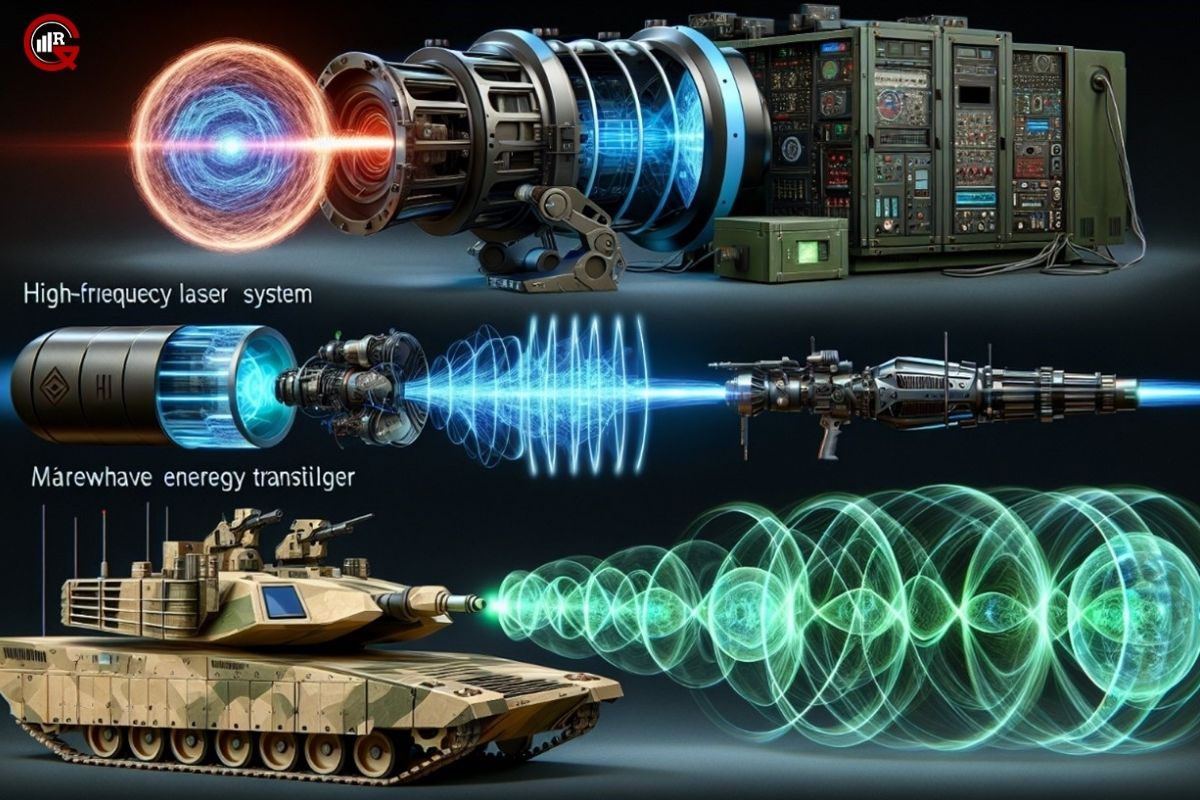Directed Energy Weapons (DEWs) represent a transformative leap in military technology, offering unprecedented capabilities to engage and neutralize targets using concentrated energy beams. Unlike conventional kinetic weapons, which rely on projectiles or explosives, DEWs harness the power of electromagnetic radiation, such as lasers or microwaves, to deliver precise and scalable effects across land, sea, air, and space domains. In this article, we delve into the fascinating world of Directed Energy Weapons, exploring their technology, applications, challenges, and implications for modern warfare.
Understanding Directed Energy Weapons:
DEW encompass a diverse range of technologies that emit focused energy beams to achieve various effects. The two primary types of DEWs are:
Laser Weapons:
- Laser weapons utilize concentrated beams of coherent light to target and neutralize enemy threats. These high-energy lasers (HELs) can be deployed on ground-based platforms, airborne systems, naval vessels, and even space-based platforms.
- Laser weapons offer several advantages, including rapid engagement, precision targeting, scalability, and reduced logistical burden compared to conventional munitions. They can effectively engage a wide range of targets, including unmanned aerial vehicles (UAVs), missiles, artillery shells, and even enemy sensors and communications systems.
Microwave Weapons:
- Microwave weapons, also known as Radio Frequency (RF) weapons, emit electromagnetic waves in the microwave frequency range to disrupt or disable electronic systems and infrastructure.
- These weapons can interfere with enemy radar systems, communication networks, electronic sensors, and other electronic devices by inducing voltage spikes, overloading circuits, or damaging electronic components.
- Microwave weapons offer non-lethal options for disabling or disabling enemy assets without causing physical harm or collateral damage, making them suitable for operations in urban environments or situations where minimizing casualties is a priority.
Applications of Directed Energy Weapons:

DEWs have a wide range of applications across military, security, and defense sectors, including:
Counter-UAV Defense:
UAVs (Unmanned Aerial Vehicles) pose a growing threat to military forces, infrastructure, and civilian populations. Directed Energy Weapons offer an effective means of countering hostile UAVs by rapidly disabling or destroying them with precision laser or microwave beams.
Missile Defense:
Directed Energy Weapons can intercept and destroy incoming missiles, rockets, and artillery shells with precision and speed. Laser-based missile defense systems, such as the Airborne Laser (ABL) and the High Energy Laser Weapon System (HELWS), offer a cost-effective alternative to traditional missile interceptors.
Anti-Personnel and Area Denial:
- Microwave weapons can be used for crowd control, perimeter security, and area denial by emitting non-lethal pulses of electromagnetic energy to deter or disperse hostile individuals or crowds.
- These weapons can disrupt electronic devices, communications systems, and unmanned vehicles, making them effective tools for controlling access to sensitive areas or protecting critical infrastructure.
Precision Strike:
- Laser weapons provide a highly accurate and scalable means of delivering precision strikes against enemy targets, including vehicles, aircraft, sensors, and munitions depots.
- By rapidly heating and destroying critical components or materials, laser weapons can disable or destroy enemy assets with minimal collateral damage, making them ideal for surgical strikes and targeted engagements.
Challenges and Limitations of DEW:
Despite their significant potential, DEW face several challenges and limitations that must be addressed to realize their full operational effectiveness:
Power and Energy Requirements:
DEW requires large amounts of electrical power to generate and sustain high-energy beams over extended durations. Power generation, storage, and distribution systems must be optimized to meet the energy demands of DEW platforms.
Atmospheric Effects:
- Atmospheric conditions, such as humidity, turbulence, and thermal blooming, can degrade the performance and effectiveness of Directed Energy Weapons by scattering or absorbing energy beams.
- Adaptive optics, beam control systems, and advanced targeting algorithms are needed to mitigate atmospheric effects and maintain beam accuracy and focus over long distances.
Thermal Management:

- DEW generates intense heat during operation, which can damage optical components, degrade beam quality, and reduce system reliability.
- Effective thermal management solutions, such as active cooling systems, heat sinks, and thermal insulation, are essential to dissipate heat and maintain optimal operating temperatures for DEW platforms.
Countermeasures and Counter-DEW Systems:
- Adversaries may develop countermeasures and counter-DEW systems to neutralize or mitigate the effectiveness of Directed Energy Weapons. These countermeasures may include reflective coatings, decoys, jamming techniques, or physical hardening of targets.
- Continued research and development are required to stay ahead of emerging threats and maintain the technological advantage offered by DEW systems.
Future Trends and Developments:
Despite the challenges, DEW continues to evolve rapidly, driven by advances in laser technology, materials science, and electromagnetic systems. Key trends shaping the future of DEWs include:
Integration with Networked Battle Systems:

- Directed Energy Weapons are increasingly integrated into networked battle systems, enabling real-time target acquisition, engagement coordination, and mission planning.
- Interoperability with existing command and control systems, sensor networks, and unmanned platforms enhances situational awareness and mission effectiveness in complex operational environments.
Miniaturization and Scalability:
- Advances in laser diode technology, solid-state lasers, and compact power sources enable the miniaturization and scalability of DEW for integration into smaller platforms, such as unmanned aerial vehicles (UAVs), ground vehicles, and individual soldier systems.
- Portable and man-portable DEW systems offer enhanced mobility, flexibility, and responsiveness for forward-deployed forces and special operations units.
Multifunctional DEW Platforms:
- Future DEW may incorporate multifunctional capabilities, such as target designation, reconnaissance, electronic warfare, and communications, in addition to kinetic effects.
- Modular and reconfigurable DEW platforms enable mission flexibility and adaptability to evolving operational requirements, enhancing the versatility and utility of Directed Energy Weapons on the modern battlefield.
Conclusion:
DEW represents a paradigm shift in military technology, offering unprecedented capabilities for precision engagement, force protection, and strategic deterrence. By harnessing the power of light and electromagnetic waves, DEWs provide scalable, cost-effective solutions for countering emerging threats, safeguarding critical assets, and maintaining superiority in the modern battlespace. While challenges remain, ongoing research, development, and innovation are driving the evolution of Directed Energy Weapons and shaping the future of warfare in the 21st century.






